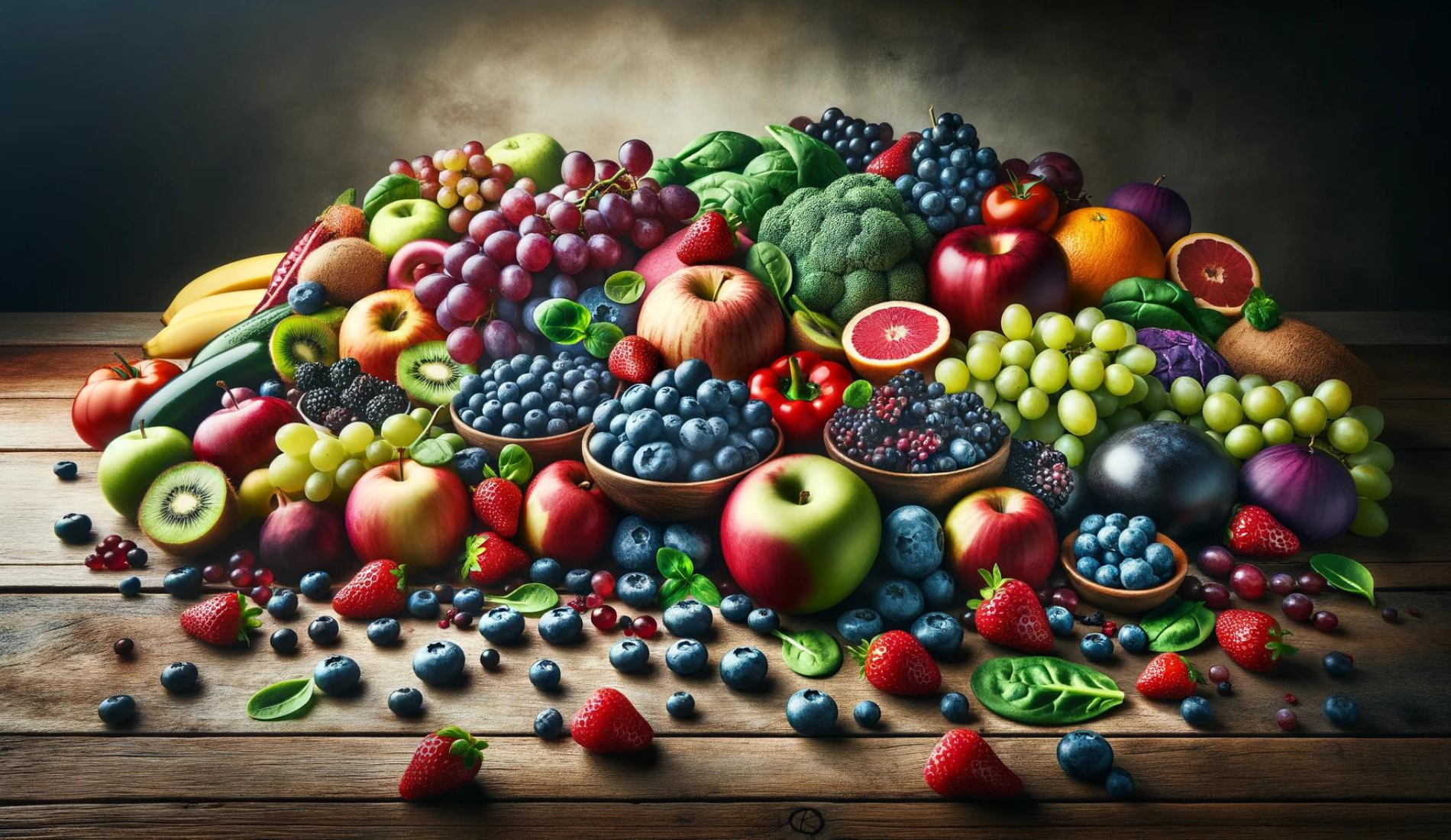Table of Contents
Introduction
Welcome to a new era of improved health and extended longevity, powered by the natural wonders of quercetin and pterostilbene. These compounds do more than fight oxidation; they offer transformative benefits that rejuvenate both body and mind. Quercetin, abundant in the vibrant skins of fruits and lush foliage, shields us from environmental toxins and stress. In tandem, pterostilbene, derived from the modest blueberry, delicately combats the effects of aging at the cellular level. These natural allies promote comprehensive wellness, enhancing cognitive functions and heart health. Incorporating these potent elements into your daily regimen can significantly improve your life's length and quality. Explore the powerful benefits of quercetin and pterostilbene and take your first step towards a healthier, more vibrant future today.
Health Benefits
Enhanced Cardiovascular Health: Quercetin promotes heart health by lowering blood pressure and reducing inflammation—critical elements in preventing cardiovascular diseases. Research shows it can improve blood vessel function and reduce the risks of atherosclerosis, a significant cause of heart attacks and strokes. Pterostilbene complements these benefits by managing cholesterol levels, breaking down lipids effectively, lowering LDL (bad cholesterol), and possibly raising HDL (good cholesterol), which helps prevent plaque build-up and heart disease.
Cognitive Function and Neuroprotection: Quercetin protects neurons from toxins and lessens the impacts of disorders such as Alzheimer's. Its antioxidant abilities help combat damage from free radicals, and its anti-inflammatory properties decrease brain inflammation, contributing to cognitive decline. Pterostilbene enhances mental functions, with studies indicating improvements in memory and learning through its influence on brain cell survival and plasticity pathways. Thanks to its potent antioxidant properties, it also helps reduce the risk of age-related cognitive decline.
Anti-Inflammatory and Antioxidant Effects: Quercetin and pterostilbene potentiate inflammation and oxidative stress, which are fundamental drivers of chronic diseases. Quercetin blocks enzymes in the inflammation pathway and curtails the production of inflammatory cytokines. As antioxidants, both compounds neutralize free radicals to prevent cellular damage, which is crucial for staving off chronic conditions like diabetes, cancer, and neurological degeneration. Pterostilbene's structure enhances its bioavailability, allowing it to enter cells and exert its antioxidant effects effectively.
Support for Metabolic Health: Research links quercetin with improved metabolic outcomes, showcasing its role in weight management and blood sugar regulation, which is beneficial for diabetes management. Pterostilbene enhances insulin sensitivity, is essential for blood sugar control, and affects lipid metabolism, supporting overall metabolic health and helping prevent metabolic syndrome.
Longevity and Overall Well-Being: Quercetin and pterostilbene possess profound anti-aging properties. Mitigating oxidative stress and inflammation extends lifespans and improves life quality. They activate cellular repair and regeneration pathways, promoting longevity and reducing age-related ailments.

Scientific Research and Studies
Quercetin's Cardiovascular Benefits: Numerous studies have validated quercetin's role in enhancing cardiovascular health, particularly in lowering blood pressure and improving vascular function. For example, research published in the Journal of Nutrition indicates that quercetin supplementation significantly lowers blood pressure in individuals with hypertension.
Pterostilbene and Cholesterol Management: Research highlights pterostilbene's efficacy in cholesterol management. A pivotal study in the Journal of Clinical Endocrinology & Metabolism reported that pterostilbene reduces LDL cholesterol and increases HDL cholesterol, effectively improving overall lipid profiles.
Neuroprotective Effects: Studies have also investigated the neuroprotective properties of quercetin and pterostilbene, particularly against age-related cognitive decline. For instance, findings in Neuropharmacology demonstrate that pterostilbene helps protect cognitive functions during aging.
Anti-Inflammatory and Antioxidant Properties: Research into these compounds' anti-inflammatory and antioxidant capabilities continues to grow. A study published in the Journal of Inflammation shows how quercetin effectively modulates inflammatory pathways, crucial in reducing oxidative stress and inflammation.
Longevity and Aging: Focusing on the anti-aging effects, quercetin and pterostilbene have been studied for their impact on cellular health and longevity. Research in Cell Death & Disease illustrates how these antioxidants promote cellular repair mechanisms, which are vital for extending a healthy lifespan.
Synergistic Effects: Exploring the combined impact of quercetin and pterostilbene, some studies suggest that these supplements offer enhanced benefits when used together. This includes improved absorption and increased efficacy, indicating a synergistic relationship that could amplify their health benefits.
This overview underscores the scientific backing behind the health benefits of quercetin and pterostilbene by referencing concrete studies and credible journals, highlighting their potential in medical and health applications.
Mechanisms of Action
Antioxidant Activity: Quercetin and Pterostilbene, two powerful natural antioxidants, combat oxidative stress by neutralizing free radicals—unstable molecules that can damage cells. By donating electrons, they stabilize these radicals, preventing further cellular damage associated with aging and various chronic diseases.
Anti-inflammatory Effects: Quercetin inhibits cyclooxygenase and lipoxygenase, enzymes producing inflammatory mediators. This action reduces inflammation and benefits conditions such as arthritis and cardiovascular diseases. Pterostilbene regulates NF-kB, a protein complex that controls DNA transcription and cytokine production, thereby moderating inflammation.
Modulation of Lipid Metabolism: Pterostilbene enhances lipid metabolism by increasing the expression of genes that promote fatty acid oxidation and decreasing those involved in lipid synthesis. This leads to lowered LDL cholesterol and increased HDL cholesterol, improving cardiovascular health.
Neuroprotective Actions: Quercetin protects neurons by maintaining mitochondrial function and preventing apoptosis, which is crucial in combating neurodegenerative diseases like Alzheimer’s and Parkinson’s. Pterostilbene crosses the blood-brain barrier to deliver antioxidant benefits directly to the brain, supporting cognitive function and protecting against oxidative damage.
Enhancement of Cellular Function and Longevity: Both quercetin and Pterostilbene activate sirtuins, proteins linked to aging and cellular repair. This enhances cellular function and metabolic regulation and potentially extends lifespan.
Synergistic Effects When Combined: Research suggests that quercetin and Pterostilbene may be more effective together than individually, possibly due to improved absorption and complementary cellular actions.

Dietary Sources
Quercetin-Rich Foods:
- Apples: High in quercetin, especially in the skin.
- Onions: Red onions are a top source.
- Berries: Including blueberries, blackberries, and elderberries.
- Capers: Known for their substantial quercetin content.
- Dark Cherries and Red Grapes: Both are solid sources.
- Leafy Greens: Such as kale and spinach.
- Broccoli: Offers quercetin and other nutrients.
Pterostilbene-Rich Foods:
- Blueberries: The primary dietary source.
- Grapes: Especially the skins of purple grapes.
- Cranberries, Mulberries, and Almonds Contain smaller amounts of pterostilbene.
Incorporating These Foods into Your Diet:
- Enhance your diet with these nutrients by adding berries to breakfast, mixing onions and capers into salads, or snacking on almonds.
- Incorporate grape juice or blueberries into beverages and use apple peels in recipes.
- Add broccoli and leafy greens to meals to boost quercetin and pterostilbene intake.

Supplementation
Types of Supplements: Quercetin is available in various forms, including capsules, tablets, and powders. It is often combined with enhancers like vitamin C or bromelain to improve absorption and boost its anti-inflammatory effects. Pterostilbene supplements are typically found in capsule form and may be paired with other antioxidants, such as resveratrol, to support anti-aging and cardiovascular health synergistically.
Recommended Dosages:
- Quercetin: Dosages generally range from 500 to 1000 mg daily, although this can vary. Adhere to the product label's dosing instructions or consult with a healthcare professional.
- Pterostilbene: Daily dosages are usually between 50 and 150 mg, depending on the concentration of the supplement and the targeted health benefits.
Combining Supplements for Enhanced Effects: Some supplements combine quercetin and pterostilbene, leveraging their mutual benefits to combat inflammation and oxidative stress more effectively.
Safety and Interactions: Potential interactions with other medications, particularly blood thinners or drugs affecting liver enzymes, should be considered, as these compounds can influence drug metabolism. While side effects are typically mild, including gastrointestinal discomfort or headaches, caution is advised with high doses due to potential health risks.
Choosing Quality Supplements: It's crucial to select supplements that provide clear information on ingredients, dosages, and manufacturing processes. Choose products from reputable manufacturers that comply with Good Manufacturing Practices (GMP) to ensure safety and efficacy.
Consultation with Healthcare Providers: Before starting any new supplement routine, it is essential to consult a healthcare provider, especially for those who are pregnant, breastfeeding, or have pre-existing health conditions. This step ensures the safety and appropriateness of the supplements for individual health needs.
Safety Profile and Side Effects
General Safety: Quercetin and pterostilbene, naturally occurring compounds found in various foods and supplements, are generally considered safe for most individuals when consumed in moderate amounts. Nevertheless, the long-term effects of high-dose supplementation remain under-documented and warrant a cautious approach.
Common Side Effects: Typically safe for consumption, quercetin and pterostilbene can cause mild side effects at high doses, such as headaches, stomach pain, or tingling sensations. Although these side effects are infrequent, they are important to consider for those planning to exceed standard dietary intake levels.
Potential Interactions: Quercetin and pterostilbene may interact with several medications, including blood thinners, chemotherapy, and liver-processed medications. Given these potential interactions, it is vital to consult healthcare professionals before supplementation, particularly if you are taking other medications.
Special Precautions: Due to insufficient research on their safety, high doses of these supplements are not recommended for pregnant or breastfeeding women. Individuals with specific health issues, like kidney disease or compromised immune systems, should also discuss their supplementation plans with healthcare providers.
Overdose and Long-Term Use: Be mindful of overdose symptoms, including increased bleeding risks (particularly with quercetin), gastrointestinal distress, or dizziness. The long-term implications of high-dose antioxidant use are poorly understood, making it crucial to adhere to recommended dosages.
Regulatory Oversight: In Australia, quercetin and pterostilbene supplements are rigorously regulated by the Therapeutic Goods Administration (TGA). Unlike the U.S., where dietary supplements are less stringently controlled, the TGA mandates a comprehensive assessment of safety, efficacy, and quality before products can be marketed. This process includes registration or listing on the Australian Register of Therapeutic Goods (ARTG), ensuring that supplements meet high standards similar to pharmaceuticals and accurately reflect their contents on labels. This robust regulatory framework gives Australian consumers a higher level of assurance when choosing supplements, underscoring the importance of selecting products that adhere to TGA standards.
Comparative Analysis with Other Antioxidants
-
Comparison with Vitamin C and Vitamin E:
- Vitamin C is a water-soluble antioxidant that is essential for the synthesis of collagen and the repair of tissues. Unlike quercetin and pterostilbene, it cannot cross cell membranes as effectively, but it is crucial for combating free radicals in aqueous environments inside the body.
- Vitamin E is a fat-soluble antioxidant that protects cell membranes from oxidative damage. While vitamin E acts primarily within the lipid layers of cells, quercetin and pterostilbene offer broader protection in water-soluble and fat-soluble areas, giving them a more versatile range of action.
Comparison with Resveratrol:
Structural and Functional Similarities: Resveratrol is often compared to pterostilbene due to its structural similarities and familiar sources like grapes and berries. Pterostilbene is noted for its superior bioavailability and longer half-life in the body, which may provide more prolonged health benefits. While both support cardiovascular health and anti-aging, pterostilbene's chemical structure allows it to penetrate cellular membranes more effectively, potentially enhancing its impact.
Synergistic Effects: Combining quercetin and pterostilbene with other antioxidants, such as vitamins C and E or resveratrol, can lead to synergistic effects. This mixture enhances the overall antioxidant capacity, creating a more robust defence against oxidative stress and inflammation. Such combinations amplify the individual benefits of each component, offering a comprehensive approach to preventing cellular damage and aging.
Unique Properties: Quercetin has distinct properties that make it particularly effective in combating allergies, such as its ability to stabilize mast cells. This contrasts with resveratrol, primarily known for its anti-aging benefits and the general antioxidant support provided by vitamins C and E. Each antioxidant has unique benefits that cater to specific health needs, from allergy relief to cellular longevity.
Clinical Implications: The differences in bioavailability and mechanism of action among these antioxidants have significant clinical implications. Quercetin and pterostilbene are often preferred in supplement form for their targeted therapeutic effects, such as improving heart health and enhancing cognitive function. In contrast, vitamins C and E are typically recommended from dietary sources to support overall health due to their widespread benefits and essential roles in various bodily functions. This highlights the importance of choosing the right antioxidant strategy based on specific health goals and the unique properties of each compound.
FAQs
What are quercetin and pterostilbene? Quercetin and pterostilbene are naturally occurring compounds known for their potent antioxidant properties. They are found in various fruits and vegetables, helping to combat cellular damage and promote overall health.
Why should I consider taking quercetin and pterostilbene supplements? These supplements offer several benefits, including enhanced antioxidant protection, improved cardiovascular health, cognitive benefits, and potential anti-aging effects. They help neutralize harmful free radicals and can support healthy aging processes.
How much quercetin and pterostilbene should I take? General dosage guidelines suggest taking 500 to 1000 mg of quercetin and 50 to 150 mg of pterostilbene daily, depending on the specific supplement form and concentration. However, consulting with a healthcare provider is crucial to receive personalized advice and appropriate dosage information.
Are there any side effects of taking quercetin and pterostilbene? While side effects are generally mild, they can include gastrointestinal discomfort or headaches, particularly at high doses. Adhering to recommended dosages is essential to minimize the risk of adverse effects.
Can quercetin and pterostilbene interact with other medications? Yes, these compounds can interact with medications such as blood thinners and drugs metabolized by the liver. It's essential to consult healthcare professionals before starting supplementation, especially if you are taking other medications.
How can I choose a high-quality quercetin or pterostilbene supplement? Look for supplements certified by third-party organizations for purity and compliance. Opting for reputable brands that follow Good Manufacturing Practices (GMP) ensures you get a high-quality product.
Can everyone take quercetin and pterostilbene supplements? While generally safe for most people, pregnant or breastfeeding women or those with specific health conditions should consult a healthcare provider before starting these supplements.
How do quercetin and pterostilbene work together? Research suggests that when taken together, they may have synergistic effects, enhancing their ability to combat oxidative stress and inflammation, leading to more significant health benefits.
What foods are rich in quercetin and pterostilbene? Foods rich in quercetin include apples (especially the skin), berries, red onions, capers, dark cherries, red grapes, leafy greens, and broccoli. Pterostilbene is primarily found in blueberries, purple grapes, cranberries, mulberries, and almonds. Incorporating these foods into your diet can naturally boost your intake of these antioxidants.
Are quercetin and pterostilbene supplements regulated? Regulatory oversight for dietary supplements varies by region. In the USA, the FDA does not require pre-market approval for nutritional supplements, while in Australia, the TGA requires a comprehensive safety, efficacy, and quality assessment before these products can be sold. Understanding these regulatory differences is essential when evaluating product quality and safety.
Shop AntioxidantsConclusion
Quercetin and pterostilbene are distinguished antioxidants that significantly benefit various health areas, including cardiovascular health, cognitive function, and general well-being. Backed by solid scientific research, these compounds effectively counteract oxidative stress and inflammation, which are central to aging and many chronic diseases.
When considering adding these supplements to your regimen, it is crucial to choose high-quality products and consult with healthcare professionals to ensure their safety and effectiveness. Whether incorporated through dietary sources or supplements, quercetin and pterostilbene have the potential to enhance your health and longevity significantly. Embracing these powerful antioxidants could promote a healthier life, offering protective and therapeutic benefits.
Disclaimer:
This article is intended for informational purposes only and should not be considered a substitute for professional medical advice, diagnosis, or treatment. Always consult your physician or another qualified health provider with any questions regarding a medical condition. The contents of this article, including text, graphics, images, and other material, are for informational purposes only and do not constitute medical advice. While every effort is made to provide current and factual information, no guarantee is made regarding the content's accuracy.
References
https://pubmed.ncbi.nlm.nih.gov/22099605/
https://www.ncbi.nlm.nih.gov/pmc/articles/PMC6982958/
https://pubmed.ncbi.nlm.nih.gov/18843589/
https://www.ncbi.nlm.nih.gov/pmc/articles/PMC3070765/
https://www.ncbi.nlm.nih.gov/pmc/articles/PMC3930840/
https://pubmed.ncbi.nlm.nih.gov/22019438/
https://pubmed.ncbi.nlm.nih.gov/21982274/
https://www.ncbi.nlm.nih.gov/pmc/articles/PMC2850944/
https://pubmed.ncbi.nlm.nih.gov/25214329/
https://pubmed.ncbi.nlm.nih.gov/22211184/






